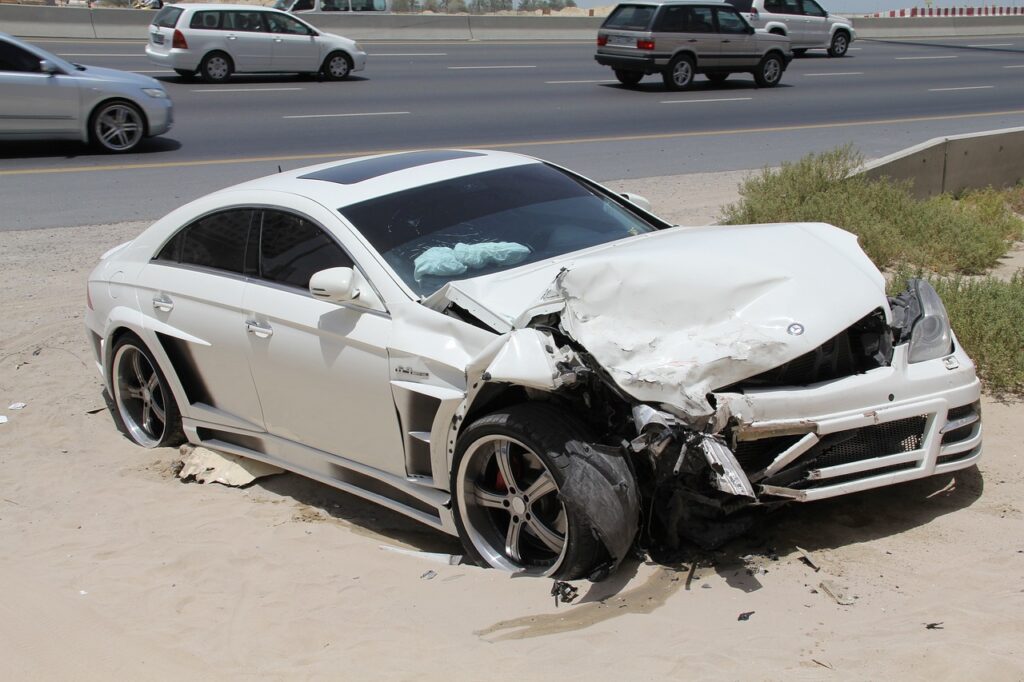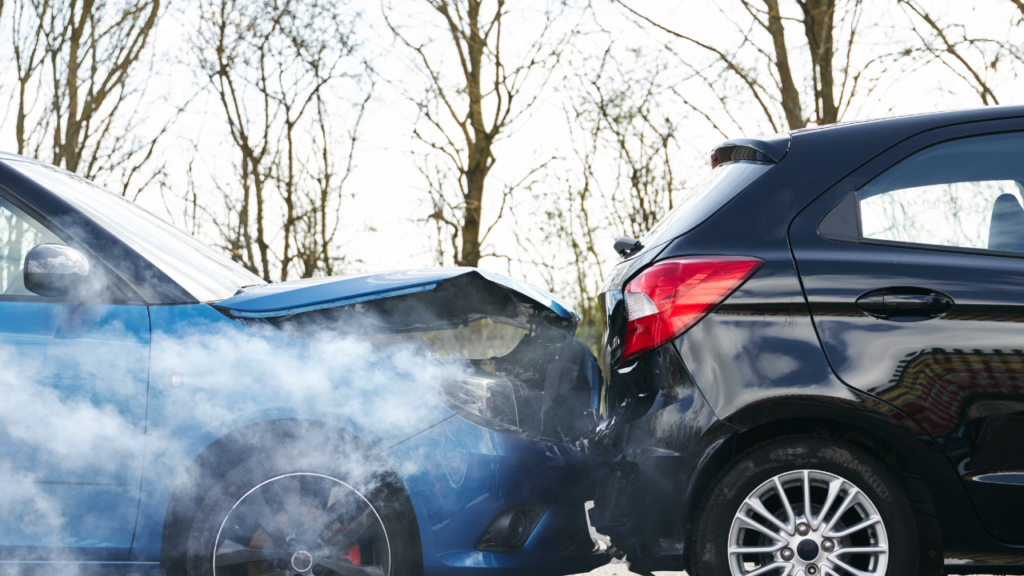Page Contents
1. Introduction
When it comes to driving, tailgating refers to a practice where a driver follows another vehicle too closely. This could lead to rear-end accidents. Rear-end collisions are common road accidents that many people may have experienced. A rear-end collision occurs when a vehicle crashes into the one in front of it.
Common factors that may contribute to such crashes include drivers that are not paying attention to the road or other vehicles, drivers that are not following the vehicle in front at a safe distance, and vehicles that are not maintained properly, for instance having faulty brakes.

It is important that all road users are aware of tailgating and its potential dangers. One should understand the need for a safe following distance and that it is against the law to tailgate. Modern vehicles are now designed with advanced driver assistance systems such as autonomous emergency braking, which are effective in preventing tailgating caused accidents.
Further reading: What Happens When You are At Fault for a Car Accident?
By learning and adapting driving habits consonant with the safe use of these technologies, we might further reduce the likelihood of tailgating and rear-end collisions. In the article, we will be discussing in detail what tailgating is and delve into the laws concerning tailgating such as the Road Traffic Ordinance and Construction and Maintenance of Vehicles Regulations in Hong Kong. We will also explore the actual cases of tailgating in Hong Kong and the possible penalties of tailgating with reference to the local law.
Finally, the article will touch on some practical tips in avoiding tailgating.
1.1 What is tailgating?
Tailgating: What is tailgating? When people hear the term ‘tailgating’, they often think of sports events. However, tailgating is also used to describe something else: driving too closely behind another vehicle. This is also sometimes called ‘close following’ or ‘rat running’. It can be very dangerous.
If the driver in front suddenly decides to brake, the driver behind may not be able to stop in time, causing a collision. Braking suddenly on a motorway can have a domino effect that can end in a serious collision. As shown in the picture on the right, the black car is tailgating the yellow car. The red arrows show that the driver of the black car is not leaving a safe gap between the vehicles.
There are regular safety messages on radio and television that warn about the dangers of tailgating. The Highway Code recommends leaving at least a two-second gap between vehicles, but this should be doubled on wet roads and increased still further on icy roads. The Road Vehicles (Construction and Use) Regulations 1986 prohibits drivers from traveling so close to a vehicle in front that they cannot stop in time to avoid a collision.
It is a separate offense when a driver commits this offense and as a result causes death or serious injury to another person. The maximum penalties for this offense are a fine of £5,000, a disqualification from driving, and imprisonment for up to two years.
1.2 Importance of understanding tailgating laws
Self-evidently, we all want to avoid getting a ticket that can only lead to wasting a lot of our money or go and get some drivers’ education. That is why we need to understand and also abide by the slogans of tailgating. To a greater or lesser degree, the need to understand tailgating laws becomes more important given that first, there are too many different laws across different states. It is sufficient to say that having some general knowledge is simply not enough. Laws on tailgating in Texas may differ from those in New York and so on, even if only slightly.

In this United States, each and every state has its own different set of traffic laws in place. What is more, these laws are not simply the same from one state in terms of the wordings of the law. They are, after all, tailored specifically for the order of that state and so the law on tailgating and how applications are to be made in e.g. Florida would be different from how that may be done in e.g. Arizona.
Further reading: Is it illegal to move your car after an accident?
Last but not least, with the progress of the law of globalization, it is expected that there will be more diverse backgrounds of drivers from various parts of the world who are used to different legal systems. The need to understand and be familiar with the laws on tailgating is never confined within the jurisdiction of the United States. Besides the points discussed above, it is helpful to know that a good understanding of the law on tailgating and its applications may help to raise awareness of this dangerous driving behavior among us, drivers.
This may bring benefits not just to ourselves in terms of being able to foresee or prepare to encounter some potential tailgating situations on the road, but also may foster a more civic attitude of accepting and adopting safe driving behaviors among members of the public.
2. Tailgating Laws
Tailgating laws across the United States vary by state. While many states have laws that prohibit tailgating, others – such as North Dakota – do not address the issue in their motor vehicle codes. This means that, if someone is involved in a tailgating-related accident there, the driver who was tailgating may not receive a citation for it.
As a general matter, law enforcement must observe a tailing driver’s behavior – such as failing to keep a proper lookout, failing to maintain safe distance and speed, and causing a rear-end collision – before issuing a citation for tailgating. Because of this, citations for tailgating may be accompanied by other citations.
For example, if a driver was cited for tailgating and for failing to maintain a proper lookout, and that driver caused an accident, the driver might also receive a citation for careless driving. And in the event that a tailgating driver causes a rear-end collision, the driver might also receive a citation for following too closely. If you are cited for tailgating and you were involved in a car accident, you may be found to be at fault for the accident as a matter of law in a subsequent civil lawsuit.
This is because a citation is evidence of the violation of a statute or ordinance. Even though the amount of damages that can be recovered is limited in no-fault car insurance states, a finding of fault against you can still cause at least some – if not all – of your personal insurance protection benefits to become available to the injured party.
For instance, in New York, where the basic no-fault insurance coverage for one person injured in a motor vehicle accident is $50,000, a finding of fault can expose you to a lawsuit for damages such as pain and suffering which, if successful, could entitle the injured party to a share of your $50,000 worth of no-fault benefits. Plus – if the injured party can establish that he has sustained a “serious injury” as defined by the no-fault law – the injured party can proceed with the lawsuit requesting additional damages.
2.1 State-specific laws on tailgating
There is no typical rule in every state of the United States. But there are a few states that are considered as strict states. For example, if you live in Illinois, inapplicable passing or so-called “tailgating” is considered as a driving offense.
Illinois vehicle code section 11-710 “following too closely” says: “the driver of a motor vehicle shall not follow another vehicle more closely than is reasonable and proper, having due regard for the speed of such vehicles and the traffic upon and the condition of the highway.”

Also, such section further states that “unless a different amount of distance is necessary to stop a vehicle, the driver of a motor vehicle on a highway must leave a distance of more than 100 feet to the rear of the motor vehicle he or she is driving, with a maximum speed in operation then, if he or she is following a car or a truck with a trailer attached.”
Further reading: Car Accident Settlement Process: Timeline, Demand Letter, and Payouts
Although the rule’s name is “tailgating”, actually it sets up the minimum “vacuum” space in between in controlled speed. In Illinois, if you are found guilty of “tailgating”, or “following too closely” reckless driving, you would probably be facing a Class A misdemeanor which is punishable by jail of up to 364 days and a fine up to $2,500. Indianapolis, Indiana.
People often have to go through several traffic when they approach their destinations. However, we should be respectful and considerate to those drivers who need to go through the same or even worse situations. Accidents caused by inapplicable passing or “tailgating” become too common tailgating in Indiana, Indiana Code of Title 9.
Motor Vehicle Code Article 21-ж-18-в-1 states that “a person who drives a vehicle shall not follow another vehicle more closely than is reasonable and prudent, having due regard for the speed of the two (2) vehicles and the traffic upon, the condition of the highway, and weather conditions.”
2.2 Consequences of tailgating
Tailgating can lead to serious consequences. If you tailgate someone and he or she makes a sudden stop, you will not have enough time to react. This will most likely result in rear-ending that person’s vehicle. You may also be found at fault for the accident and have to pay for the damages to the other person’s vehicle, your vehicle, and any other property damages that occurred from the accident.
Rear-end accidents are the most common type of car accident. In fact, according to the National Highway Traffic Safety Administration, there are about 1.7 million rear-end collisions every year in the United States. These accidents cause approximately 1,700 deaths and 500,000 injuries each year.
Given the statistics, if you do not keep a safe following distance, you are likely to cause an accident. If you get a ticket for tailgating, there is usually an inexpensive fine associated with the ticket. However, the total monetary cost of a tailgating ticket will include more than the fine you see written on the ticket; your insurance rates may go up.
Recurrent tickets or serious accidents resulting from tailgating can lead to more serious legal ramifications, such as a misdemeanor charge for reckless driving. Reckless driving typically involves any form of driving behavior that demonstrates a willful or wanton disregard for the safety of persons or property.
Penalties for a misdemeanor charge of reckless driving can include large fines and possible incarceration. In Virginia, for example, you can be fined up to $2,500 and imprisoned for up to 12 months.
2.3 Enforcement of tailgating laws
Officers have a variety of methods available to effectively prevent and catch tailgating. Law enforcement officers are often trained to look out for certain kinds of driving behavior that are especially dangerous, such as tailgating. Therefore, some local police forces dedicate a specifically trained unit to deal with aggressive driving.
This is generally done by giving the unit additional funding to be used to pay the officers’ wages for tailgating enforcement and the potential costs of running the unit. Also, unmarked police cars are sometimes used to help identify and catch tailgaters.
This is because they are less easily noticeable on the road than regular police cars and so are more likely to catch drivers acting unlawfully through tailgating. In many cases, unmarked cars are used by the police with either video recorders or digital cameras to take photographs of the tailgater as evidence to be used in prosecution.

However, there are protections in place if a driver feels that they were wrongly stopped and accused of tailgating. If an individual is prosecuted for tailgating under section 2 of the Road Traffic Act 1998, which makes it an offence to drive without reasonable consideration for other road users, the evidence required is proof that the tailgater’s driving was aggressive.
Further reading: How to get the highest settlement money?
Although it is not necessary to show any detrimental effect on any other road user, either an act beyond mere negligence or driving that could be classed as willful or showing a disregard for the safety of other road users must be demonstrated. However, if the prosecution is under section 3 of the 1988 Act – which states that drivers are prohibited from driving in a public place without reasonable consideration for other persons – the court must have regard to the standard of driving of an ordinary careful and considerate motorist.
In other words, if a driver was prosecuted under this section, it is necessary to show not only that their standard of driving fell below that of an ordinary careful motorist, but that it was beyond mere carelessness.
This is the highest standard of driving and is essentially a requirement to prove a higher level of fault than under section 2. The law is complex and what you would need to show depends on which section of the Road Traffic Act 1998 is referred to. By Failures to comply with a traffic sign – Road Traffic Regulation Act 1984 – and Robert Taylor, Solicitor at law.
3. Tips for Avoiding Tailgating
Last but not least, aggressive driving behaviors such as tailgating should be avoided. Tailgating is not only dangerous but it is a form of aggressive driving. Other examples of aggressive driving behaviors include frequent and quick lane changes, speeding, running red lights and disobeying traffic signs. It is considered a traffic offense and is illegal under the Road Traffic Act.
Aggressive driving contributed to 56% of fatal crashes over a six-year period, according to statistics from the National Highway Traffic Safety Administration. Driving at speeds well over the speed limit, with the express aim of preventing the driver behind from overtaking and preventing other drivers from pulling in front of you are all types of aggressive driving. In most states, including the Commonwealth of Kentucky, these are treated as a serious traffic misdemeanor.
Tailgating is a ‘primary offense’ – which means that if a police officer sees you tailgating, you can be pulled over and ticketed. However, tailgating can also lead to more serious consequences, such as contributing to the cause of an accident involving injuries. Penalties for this type of ‘reckless’ or ‘aggravated’ driving include heavy fines, court costs, the loss of your driving license, and even imprisonment.
Thirdly, staying calm is crucial. It’s very easy to respond to tailgating by getting angry or even resorting to aggressive behavior. However, this will not help the situation – and it will only serve to make you a more dangerous driver. According to the American Automobile Association, more than half of all drivers have driven aggressively at least once. This could involve behaviors such as tailgating or horn honking. However, over 90% of drivers consider aggressive drivers to be a threat to their safety. Always report aggressive drivers to the authorities if possible.
Secondly, using turn signals effectively is another key tip. Before you change lanes, or make a left or right turn – you should always signal. The signal should be given continuously for sufficient distance to alert drivers of your intention. It is particularly important to signal correctly when you are parking at the side of the road. As a general rule, you should use your signal even if no one else is on the road. This is good driving, and it helps to develop a habit which will help avoid accidents.
First of all, the most important tip for avoiding tailgating is maintaining a safe following distance. This means that you should keep a safe distance between your car and the car in front of you at all times. According to the National Safety Council, a following distance of three seconds is recommended for speeds of 45 mph or less – and more in bad weather. At night, this distance should be increased even further.
It can be tricky to measure the distance between two cars in seconds. However, it is relatively easy. When the car in front of you passes a certain fixed point – such as a sign or a lamp post – you should be able to count ‘one thousand and one, one thousand and two, one thousand and three’ before you pass it.
3.1 Maintaining a safe following distance
This is what is known as the “three-second rule”. By choosing a fixed object on the road ahead – perhaps a lamp-post, a road sign, or a bridge – and counting how long it takes for your vehicle to pass that object after the vehicle in front of you has, you can work out whether you are following at a safe distance. Of course, two seconds should be the minimum.
If there is bad weather, such as heavy rain or snow, or if there is a poor road surface, such as gravel or mud, motorists should increase their following distances in line with the advice given in the Highway Code. Personal injury solicitors often stress the importance of this guidance in the context of motorway driving.
This is because the combination of the high speeds commonly seen on motorways and the likelihood that a tailgating driver could cause – or greatly exacerbate – a multi-vehicle collision means that maintaining a safe following distance is particularly important. In general, it is very important for motorists to take care when tailgating on the roads, especially in busy traffic.
If a driver fails to maintain a safe following distance and, as a result, causes a collision with another vehicle, that driver could be seen to have driven without due care and attention or without reasonable consideration for other road users – both of which are penalised by law.
These offences, which can be punished through penalty points, fines, driving bans, or even imprisonment, are often referred to as ‘tailgating offences’ by those working in the field of traffic law. So, seeking early advice from a qualified lawyer after a collision could be important to secure the best chance of a successful legal claim or case – particularly if the tailgating was not your fault.
3.2 Using turn signals effectively
Now, let’s talk about how to use turn signals effectively and the role that proper use of turn signals on your car can play when it comes to avoiding getting ticketed for tailgating. Turn signals were created to inform other drivers of your intentions as you operate your vehicle.
Any time you make a turn or even change lanes in traffic, you must use your turn signals. Your turn signals have the power to warn other drivers of your plans to shift your position on the road. This can go a long way in preventing tailgating since the more that other drivers are aware of your plans and where you intend to go, the less likely they will be to follow too closely behind your vehicle.
As you get in the habit of using your turn signals properly, you may even notice that your drives are less stressful since you are far less likely to find someone right on your bumper. It’s important to remember that failing to signal promptly and then making a sudden turn or lane change can have the same effect as tailgating. If you don’t give other drivers a chance to take appropriate action based on the information you provide with your turn signals, you could be found responsible for a collision.
So, make sure to give both yourself and other drivers enough time to react to a lane change situation by using your turn signal plenty of time before you make any move. That’s at least 100 feet before changing lanes on a highway and at least 3 seconds prior to a turn in traffic.
Keep in mind that when making a turn, your turn signal should be on to alert other drivers throughout the whole turning process. And when you have completed a turn and your car is straightening out again, be sure to manually turn off the blinker. This way, drivers behind you won’t be given incorrect signals by a forgotten turn signal.
So, the take away from all of this should be that using turn signals to their full potential is a key strategy in making sure that you drive as safely and legally as possible. By employing turn signals effectively to broadcast your intentions to other drivers indiscriminately, you will help to make the roads a safer and happier place for all of us.
3.3 Staying calm and patient on the road
Next time you face a tailgater, remember a few simple things that can help keep a potentially dangerous situation “in control” and maybe even help to “loosen” the situation up. For example, try to ignore the tailgater. Do your best not to allow the tailgater’s presence to affect the way you are driving.
Let the tailgater pass. If there is more than one lane in your direction and it is safe to change lanes, you should move over and allow the tailgater to pass you. The article takes an imperative and meticulous tone with the subject by explaining several very different and yet still viable options for avoiding an incident with a tailgater in progress. In conclusion, this essay is written very well.

It will explain every known technique to deal with tailgaters. There are tons of different drivers out there, from the student driver to the “Sunday driver” to the average kook, but nothing is worse than a driver who tailgates. With everything mentioned, I firmly believe that by following some of my tips and warning signs, a situation with a tailgater could be easier to get away from and maybe even prevent any injury with an aggressive tailgater. I also believe that my tips could open your life to “an aggressive driver, well just distractions on the road.”
And that is the end of my guide. It means my guide is now ready to be used for help or fending off a tailgater. Thank you for paying attention and reading my guide. I hope that it will help.
3.4 Avoiding aggressive driving behaviors
Finally, try to avoid aggressive driving behavior, one of the most common reasons people tailgate. Examples of aggressive driving include speeding, changing lanes to block cars from passing, making rude and obscene gestures, and cutting off other drivers.
Violations of aggressive driving laws are usually charged if a driver commits a moving traffic offense and the violation is a result of the moving traffic offense or if there is a crash resulting from the moving traffic offense. It is also possible that an aggressive driver may be charged with a criminal offense if the driving behavior was so severe or reckless that it created a risk of injury or harm to someone else.
Penalties of a traffic citation for aggressive driving include possible jail time in more severe cases, mandatory counseling, community service, a lengthy driver’s license suspension, a great deal of stress and added expense, including court costs and fines that could exceed well over in some cases; increased risk for a road rage attack from those targeted by aggressive drivers; and most importantly, the risk of harming oneself or others as a result of aggressive driving.
Some states even define some of the behaviors such as cutting off another driver, flashing headlights, and blocking cars from passing as aggressive driving with specific penalties or fines.
Always pay attention to the dashboard to see how fast the car is moving and use the speed as a reference to find out whether the car is being driven aggressively. If for some reason the driver is running late and there are still plenty of cars on the road, there is no need to be stressed out on the road and tailgate other drivers to go faster. Instead, leave at a proper time to get to the destination.
4. Conclusion
After thorough exploration and analysis, it is clear that tailgating is illegal and can have serious consequences. Therefore, it is important to understand tailgating and keep a safe distance from the vehicle in front. Tailgating can lead to high-risk situations and accidents.
So, it’s important for drivers to avoid tailgating at all times and stay patient and calm on the road. The best practice is to always keep a safe following distance to avoid rear-end crashes. Proper and timely use of turn signals can also help to notify surrounding traffic of intended moves to encourage other drivers to make room to execute the move. It is crucial to follow state-specific tailgating laws and pay attention to traffic signs and signals.
If someone finds themselves on the road with a tailgater, it’s important to stay patient and calm. You should avoid any behaviors that can stimulate an aggressive driver. It is important to remember under no circumstance to give into aggressive driving. Attempting to block a tailgater is not recommended and can result in a road rage accident. Always keep in mind that the risks of tailgating far outweigh the benefits, if any.
Every driver on the road should maintain a safe distance from the vehicle in front. Safe distances should be increased at higher speeds and in adverse weather conditions. Last but not least, drivers should consider taking alternate measures in an attempt to reduce the possibility of encounters with tailgating drivers. Such measures can include increasing following distance or even pulling over to allow the other driver to get ahead.







